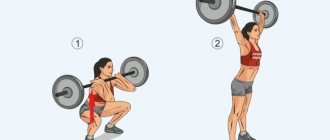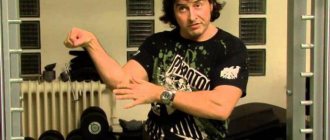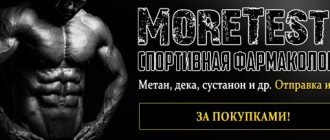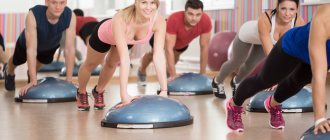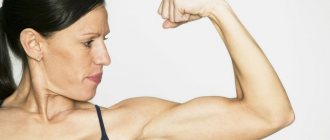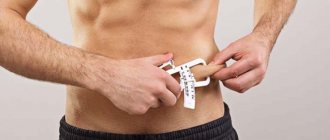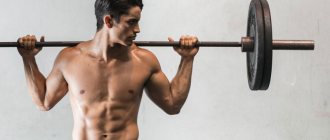Text: Karina Sembe
Sports have long been an important part of life: training uniforms have penetrated into street fashion, and in conversations at an exhibition or in a bar you can increasingly hear words like “hyperextension” and “cheat meal”. Fitness terms are used not only for the sake of a catchphrase: training programs are entirely supersets and drop sets, and even the instructions of an aerobics instructor seem vague at times. There is a need to find out what the most common words in sports jargon mean. It’s not a fact that the jokes of amateur bodybuilders about gaining mass will now seem funny, but it will certainly become clearer what the coach is talking about.
↑ Burpee
Anaerobic load
Exercises with short-term effort, when energy is produced not from oxygen supplied to the muscles with the blood, but from the reserve of “fuel” substances in the muscles. True, after 8–12 seconds the body begins to use oxygen and the exercise becomes aerobic (hence the popularity of interval anaerobic training, in which each set is followed by 8–20 seconds of rest). Anaerobic exercise predominates in powerlifting, bodybuilding, and sprinting, while aerobic exercise predominates in long-term endurance training, from cycling to cardio training and aerobics itself.
https://youtu.be/nqtVMpz5lGk
A
Antioxidants are vitamins and minerals that protect our body from the effects of free radicals (extremely aggressive fragments of molecules) formed as a result of increased metabolism and environmental influences (say, during heavy training), exposure to a polluted environment, and exposure to certain chemicals. The influence of free radicals is directly associated with the occurrence of cancer, blockage of blood vessels, seizures and premature fatigue. The following vitamins A, C, E, beta-carotene, selenium and zinc, as well as certain biologically active substances of plant origin, are considered to destroy free radicals.
Anabolic steroids are doping drugs (substances with a complex chemical composition) that retain protein in the muscles, and are important when used to weaken the effect of a number of painful conditions. These medications cause unwanted side effects, especially steroids, which are very dangerous drugs. Avoid using steroids - they are sources of liver cancer and heart disease. Avoid using doping in your training.
Anthropometry is a scientific term, a section of sports metrology that deals with the study and recording of linear dimensions and other physical characteristics of the human body (weight, height, density, circumference, etc.). In bodybuilding - circumference, volume of muscle groups, body and limbs.
Atrophy is a decrease in size or decrease in the functional properties of an organ of the body or system. If not caused by a specific disease, then it is associated with insufficient use of a given organ or system. Such “non-use” leads to a decrease in the lumen of the vessels supplying a given region or organ, a decrease in the strength and scale of innervation, hence to a limitation of nutrition (the origin of the term is in Greek “a” is “not”, “trophos” is “nutrition”). .
The amplitude of movement is the trajectory of the projectile in exercises.
Abduction is a movement of a limb directed away from the central axis of the body. Abduction of the leg to the side in the longitudinal lateral plane, or abduction of the arm in the same plane - practically, raising it to the side from a hanging position to a position at shoulder level.
Adduction is the movement of a limb towards the central axis of the body. Examples of adduction could be bringing the knees together while sitting on a special exercise machine, lowering the arms through the sides and down on the exercise machine.
Actin is a muscle cell protein that is involved in the mechanism of muscle contraction. Its synthesis requires essential amino acids and stimulation of muscle fiber to enhance metabolic processes.
An anti-catabolic is a substance that has the properties of reducing the secretion of cortisol or partially neutralizing its effects. Dietary supplements in this class for athletes currently include ornithine ketoglutarate (OKG) and phosphatidylserine (PS).
Amino acids are a class of organic compounds that have the properties of both acids and bases. Participate in the metabolism of nitrogenous substances in the body (initial compounds in the biosynthesis of hormones, vitamins, mediators, pigments, purine bases, alkaloids, etc.).
Anabolism is a set of metabolic reactions in the body corresponding to assimilation (assimilation and accumulation of substances external to the body) and aimed at the formation of complex organic substances, such as muscle fibers (counterweight-catabolism).
Blood pressure (blood pressure) is the pressure of blood in the vessels, caused by the work of the heart and the resistance of the artery walls. It decreases with distance from the heart - the greatest in the aorta, much less in the veins. Normal pressure for an adult is considered to be 100-140/70-90 mmHg. Art. (arterial) and 60-100 mm water. Art. (venous).
Androgens (gr. andros - man, genos - genus) are chemical substances that act in the body like the male sex hormone - testosterone.
Accordingly, Androgenic - characterized by male sexual characteristics - skeletal structure, muscular system, etc.
Aromatization is the conversion of testosterone to estrogen, the body's natural response to increased testosterone levels. It is not a fixed amount of testosterone that is converted, but a percentage of the total amount of testosterone in the body; the more testosterone, the more estrogen. The term is used to characterize an anabolic steroid by its ability to cause a number of side effects, gynecomastia, for example.
ATP is adenosine triphosphoric acid, an energy-rich compound. Any organic cell receives energy obtained from the breakdown of ATP. This compound (or rather its synthesis, resynthesis and optimal expenditure) is extremely important for strength training, since the reduction of white muscle fibers depends entirely on its reserves. They are distinguished (ADP - adenosine diphosphoric acid, AMP - adenosine monophosphoric acid).
Aerobic exercise is a long-term exercise with low intensity (intensity is the level of exercise from the maximum maximum). Running and cycling are examples of aerobic exercise. Aerobic exercise is an excellent (within reasonable limits) anabolic agent. Indispensable for cardiovascular training.
Anaerobic load - “aero” - air, “anaero” - without air, a load of a strength nature, a short burst of energy.
Gainer
(English gain - to extract, receive)
A sports nutrition product with a high content of carbohydrates (simple or complex) and some protein, which is used to gain muscle mass: carbohydrates are the best fuel for physical activity in the gym, and protein is an essential building material for muscle growth.
↑ Deltas
M
Mass-volume of body muscles
The dead spot is a limited area of amplitude in which gravity and the unfavorable location of the bony levers make movement most difficult.
Muscularity is a combination of mass and definition of muscle relief.
Mind-muscle coupling refers to extreme concentration and mental representation of muscles contracting and relaxing during an exercise.” Thus, you acquire the skills to control the work of the muscles being trained. This promotes the conduction of impulses from the brain to the muscles.
Microelements are chemical elements (iron, copper, zinc, etc.) contained in the body in low concentrations and necessary for its normal functioning. They enter the human body with food and are part of a number of enzymes, vitamins, and hormones. A deficiency or excess of these leads to metabolic disorders.
Myoglobin is a globular protein that stores oxygen in muscles.
Metabolism is the general name for the totality of metabolic processes in the body, including anabolism and catabolism.
Mitochondria are organelles located in the cellular substance (sarcoplasm), in which metabolic processes occur and energy-rich substances, such as phosphates, glycogen and fats, accumulate.
Myofibrils are filaments that form the basis of a muscle cell. They consist of small, sequentially connected elementary blocks, also called sarcomeres, and are located along the entire length of the cell. Myofibrils are essentially the contractile elements of muscles.
Crunch
(English: crunch)
The fashionable name for good old abdominal exercises comes from the English language. The literal meaning of the word crunch is “crack”, “crunch”, but with the correct technique, crunch should not be accompanied by either a crack or a crunch: lifting and/or twisting of the upper body is performed not by inertia, but by muscle contraction.
↑ Hitch
Names of body parts in alphabetical order:
- ankle (ankle, ankle)
- arm (hand)
- back (back)
- balls of the feet
- belly button (belly button)
- big toe (big toe)
- breast (chest)
- buttocks (butt) (buttocks)
- calf (shin (calf))
- chest (chest)
- chin (chin)
- ear (ear)
- elbow
- finger (finger)
- fingertip (fingers of hand)
- foot (leg (foot))
- forearm (forearm)
- forehead (forehead)
- fourth toe (ring toe)
- fourth, ring finger (ring finger)
- glutes (buttocks)
- hand (brush)
- head (head)
- heel (heel)
- hip (thigh)
- index finger (index finger)
- index toe (index toe)
- knee
- leg (leg)
- little, pinky finger (little finger on hand)
- little, pinky toe (little toe)
- lower back (lower back)
- lumbar (low back)
- middle finger (middle finger)
- middle toe (middle toe)
- neck
- palm (palm)
- pelvis (pelvis)
- rib cage (chest)
- sacrum (sacrum)
- shin (shin)
- shoulder
- shoulder blades
- spine
- stomach (stomach)
- tailbone
- thigh
- thumb (thumb)
- tiptoe, tiptoes, tippy toes (chicks)
- toe (toe)
- torso (trunk)
- vertebra (vertebra, spine)
- waist (waist)
- wrist (wrist)
Refusal
Something to which it is not at all necessary to bring the training, even if the trainer advises the opposite. We are talking about working “all the way”, that is, until the moment when it seems that there is no strength for the next repetition of the exercise: the neurons are damaged and lose the ability to transmit an electromechanical impulse. Withdrawal training reduces plasma insulin-like growth factor (IGF-1) levels, increases cortisol production, and can damage the endocrine and nervous systems in the long term.
Basic fitness terms representing the names of innovative and classic trends
- Aqua-ji. One of the variants of Chinese gymnastics Tai Ji Yuan, performed in the pool.
- Bodyflex. A high-intensity complex consisting of specific exercises accompanied by a special breathing technique.
- Bushido. A group of Japanese martial arts (this includes aikido, karatedo, judo and others).
- Jogging. Jogging.
- Pilates. A set of exercises aimed at stretching and strengthening muscles, increasing flexibility, and developing endurance.
- River dance. Dance class with elements from Irish dances.
Protein
In the world of fitness, it is a sports nutrition product based on protein mixtures that serves to reduce body fat, stimulate muscle growth and maintain physical fitness. Depending on goals and preferences, they use whey, egg, soy, rice or other protein with different flavors. In addition to protein powder, there are not only familiar bars on sale, but also protein yogurts, cereals and even ice cream.
↑ Weighting
AND
Isokinetic exercises are exercises with varying resistance along the movement, changing in different areas of the amplitude; exercise with a constant speed of weight movement.
Isometric exercise – an exercise in which the muscle is tensed while maintaining its constant length; the limbs do not move. These exercises are usually performed against a wall or some stationary object.
Isotonic exercise is muscle work in which its length and the amount of weight are changed, but the tension remains constant; lifting free weights is a classic example of isotonic exercise.
Intensity is the degree of tension with which you exercise. Expressed as a percentage of your rep max.
Cheating
(English: cheating)
A technique in bodybuilding and powerlifting in which the weight of the apparatus in the positive phase of movement, that is, in the phase when muscle contraction occurs, moves from the engaged (and tired) muscle group to other, not fatigued ones. Cheating is also called certain “loading days”, when the usual amount of calories consumed is 50–70% higher in order to “hint” the body that it does not need to store energy reserves in the form of fat. According to many nutritionists, situational overeating, including cheat meals, is not good for the digestive system.
Photos: Nike Pro Bra, Dear Kate/Facebook, Nike/Instagram (1,
AND
Fats are one of the main components of cells and tissues of living organisms. Contained in all tissues, they are among the main nutrients in food products, the richest in energy. The fat content in blood serum is an important diagnostic sign for a number of diseases; genetically determined disorders of fat metabolism are the cause of severe hereditary diseases. The daily human need for fat is on average 70 g (animal and vegetable origin).
A burning sensation is a mild discomfort felt in the muscles after they have been subjected to exercise of extreme intensity. This is not dangerous and simply means that the nerve endings in the muscle are signaling that there is excess fat that causes fatigue and that the muscle needs more oxygen.
Various fitness terms:
- balance (balancing, balance, balance, maintain balance)
- barefoot (barefoot)
- Barely (barely, slightly)
- carbohydrate (carbohydrate)
- carbs, carbohydrates (carbohydrates)
- cardiovascular (cardiovascular)
- clasp (compress)
- cross (to cross)
- downward (down)
- endurance
- exhale (exhale)
- fat (fat)
- flare out (to come out)
- flex (bend)
- flexibility
- grab (grab)
- inhale (inhale)
- injury
- lateral (lateral, longitudinal)
- lift (to raise)
- nutrition (nutrition)
- pace
- protein
- range of motion
- relax (relax)
- release (let go, relax)
- repetition, rep (repetition)
- reverse
- rotate (rotate)
- second wind, second breath (second wind)
- squeeze (compress)
- stamina (endurance)
- steady (evenly, calmly, steadily)
- straight (straight, straight)
- strength
- tension (tension, tension)
- towel (towel)
- upward (up)
- weight
- wide
Natasha Samoilenko (c).
Muscle names in alphabetical order:
- abs, abdominal, six pack (abdominal muscles)
- adductor muscles (adductor muscles of the thigh)
- biceps (biceps)
- calf, calves (shin (calf))
- connective tissue (connective tissue (ligaments, tendons, joint))
- deltoid, delts (delta, deltoid muscle)
- gluteus maximus (gluteus maximus)
- gluteus medius (gluteus medius muscle)
- gluteus minimus (gluteus minimus)
- hamstring, biceps fernoris (biceps femoris muscle)
- joint
- ligament
- muscle (muscle)
- obliques (oblique abdominal muscles)
- pectoralis (pectoral, pectoral muscles)
- quadriceps, quads (quadriceps (quadriceps))
- rectus abdominus (visible part of the abs)
- traps (trapezius)
- triseps (triceps)
This is interesting: Winter diet for weight loss. What you should pay attention to when choosing a menu for the month

